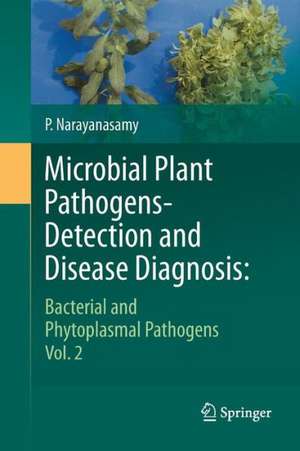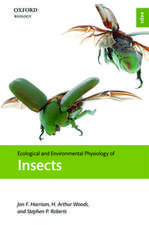Microbial Plant Pathogens-Detection and Disease Diagnosis:: Bacterial and Phytoplasmal Pathogens, Vol.2
Autor P. Narayanasamyen Limba Engleză Paperback – 11 noi 2014
| Toate formatele și edițiile | Preț | Express |
|---|---|---|
| Paperback (3) | 936.79 lei 6-8 săpt. | |
| SPRINGER NETHERLANDS – 11 noi 2014 | 936.79 lei 6-8 săpt. | |
| SPRINGER NETHERLANDS – 6 noi 2014 | 939.75 lei 6-8 săpt. | |
| SPRINGER NETHERLANDS – 8 noi 2014 | 1208.77 lei 6-8 săpt. | |
| Hardback (3) | 942.72 lei 6-8 săpt. | |
| SPRINGER NETHERLANDS – 29 oct 2010 | 942.72 lei 6-8 săpt. | |
| SPRINGER NETHERLANDS – 3 noi 2010 | 945.86 lei 6-8 săpt. | |
| SPRINGER NETHERLANDS – 29 oct 2010 | 1214.70 lei 6-8 săpt. |
Preț: 936.79 lei
Preț vechi: 1142.42 lei
-18% Nou
Puncte Express: 1405
Preț estimativ în valută:
179.41€ • 184.85$ • 150.29£
179.41€ • 184.85$ • 150.29£
Carte tipărită la comandă
Livrare economică 24 februarie-10 martie
Preluare comenzi: 021 569.72.76
Specificații
ISBN-13: 9789400790025
ISBN-10: 9400790023
Pagini: 280
Ilustrații: XXII, 256 p.
Dimensiuni: 155 x 235 x 15 mm
Greutate: 0.4 kg
Ediția:2011
Editura: SPRINGER NETHERLANDS
Colecția Springer
Locul publicării:Dordrecht, Netherlands
ISBN-10: 9400790023
Pagini: 280
Ilustrații: XXII, 256 p.
Dimensiuni: 155 x 235 x 15 mm
Greutate: 0.4 kg
Ediția:2011
Editura: SPRINGER NETHERLANDS
Colecția Springer
Locul publicării:Dordrecht, Netherlands
Public țintă
ResearchCuprins
Volume 2.- Chapter 1 Introduction.- 1.1. Microbial plant pathogens as a major limiting factor of crop production.- 1.2. Discovery of bacteria as plant pathogens.-1.3. Detection of bacterial and phytoplasmal pathogens and disease diagnosis.- References.- Chapter 2 Detection of Bacterial and Phytoplasmal Pathogens in Plants.- 2.1 Detection of bacterial pathogens in plant organs.- 2.2 Detection of phytoplasmal pathogens in plant organs.- 2.3 Detection of bacterial pathogens in seeds and planting materials.- 2.4 Detection of phytoplasmal pathogens in planting materials.- Appendix.- References.- 3. Detection of Bacterial and Phytoplasmal Pathogens in the Environment.- 3.1 Detection of bacterial pathogens in environment.- 3.2 Detection of phytoplasmal pathogens in environment.- Appendix.- References.- Chapter 4 Assessment of Variability in Bacterial and Phytoplasmal Plant Pathogens.- 4.1 Assessment of variability in bacterial pathogens.- 4.2 Assessment of variability in phytoplasmal pathogens.- Appendix.- References.- Chapter 5 Diagnosis of Bacterial and Phytoplasmal Diseases.- 5.1 Choice of diagnostic tests for bacterial diseases.- 5.2 Choice of diagnostic tests for phytoplasmal diseases.- 5.3 Agencies involved in disease diagnosis.- References.
Textul de pe ultima copertă
The bacterial and wall-less phytoplasamal pathogens are comparatively much smaller than fungal pathogens. The morphological characteristics of bacterial pathogens have limited application for their detection and identification. Hence, cultural, biochemical and physiological characteristics have to be determined for the detection and identification of bacteria up to generic/species level. Immunoassays have been shown to be highly efficient for detection, identification and differentiation of isolates, strains and/ or pathovars of bacterial species. Application of various nucleic acid-based techniques based on hybridization of probes with complementary sequences of target bacterial pathogen DNA and / or amplification of unique sequences of the target bacterial species has been demonstrated to yield reliable and reproducible results rapidly. The nonculturable phytoplasmas have to be detected in plants, planting materials and the vectors involved in the transmission of these disease-causing agents from plant to plant. They have been identified and classified primarily based on the techniques based on the genomic nucleic acid characteristics. The comprehensive information presented in this volume, following extensive literature search is aimed to provide all that is required by the researchers, teachers and students of various disciplines of biological sciences, in addition to the extension pathologists, and personnel of plant quarantines and certification programs. The inclusion of a wide range of protocols is the unique feature of this volume enabling the scientists to choose the methods for their investigations.
Caracteristici
Presentation of essential and latest information on detection of bacterial and phytoplasmal plant pathogens and diagnosis of the diseases caused by them Discussion on all aspects of pathogen detection based on extensive literature search Inclusion of a wide range of protocols for detection of bacterial and phytoplasamal pathogens in plants and environmental samples
Recenzii
From the reviews:
“The first volume of the Microbial plant pathogens - Detection and disease diagnosis focuses on fungal pathogens. … All chapters are summarized in the abstract, well referenced and focused on providing concerns of techniques and improvements of research. Therefore, if you are interested in the methods for detection and diagnosis, this is certainly a book you must have. The book should be available to every mycologist and students studying any aspect of plant pathology. Every library in the world should also have this book.” (Dhanushka Udayanga and Dimuthu S. Manamgoda, Fungal Diversity, April, 2012)
“The first volume of the Microbial plant pathogens - Detection and disease diagnosis focuses on fungal pathogens. … All chapters are summarized in the abstract, well referenced and focused on providing concerns of techniques and improvements of research. Therefore, if you are interested in the methods for detection and diagnosis, this is certainly a book you must have. The book should be available to every mycologist and students studying any aspect of plant pathology. Every library in the world should also have this book.” (Dhanushka Udayanga and Dimuthu S. Manamgoda, Fungal Diversity, April, 2012)













